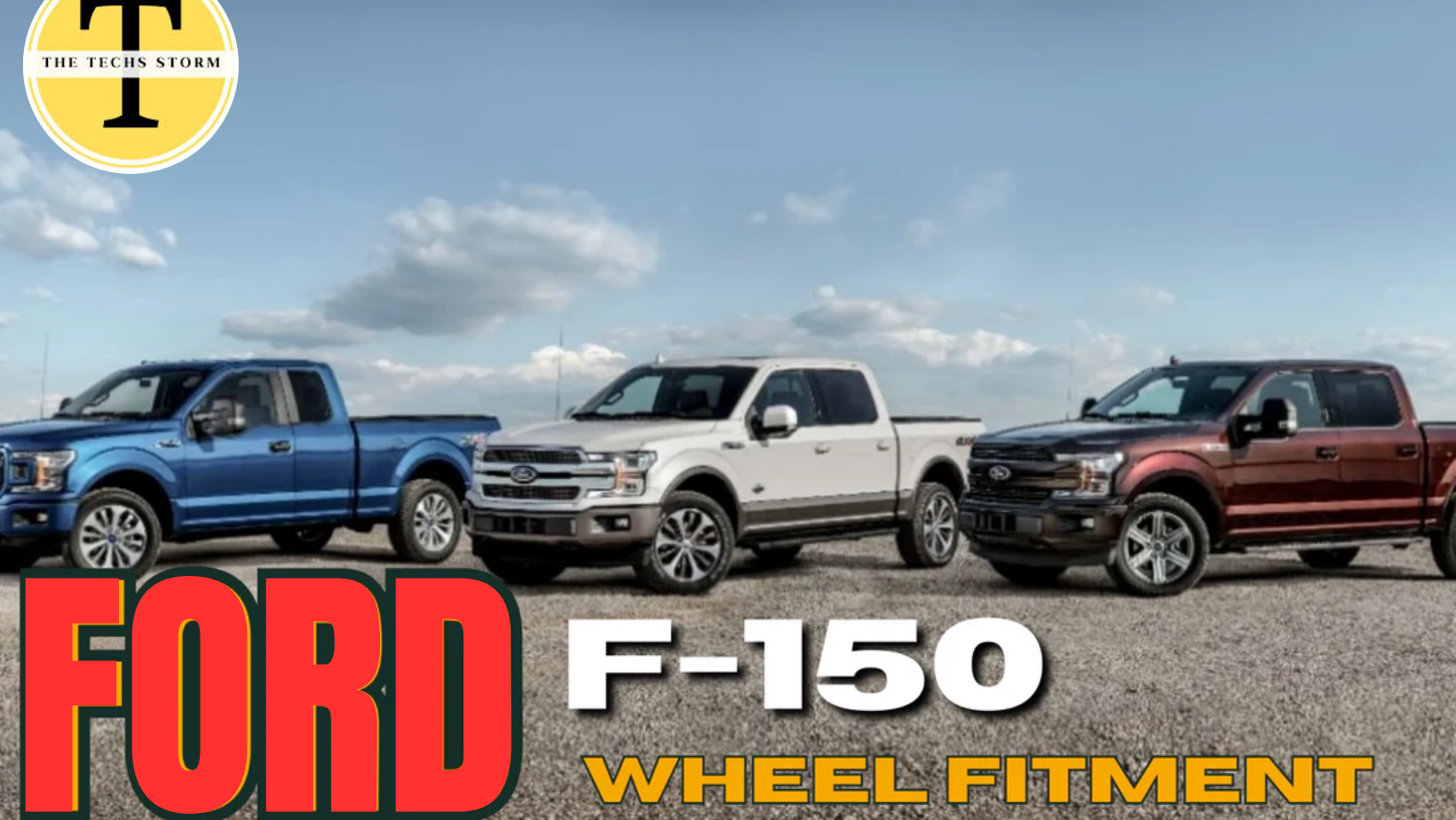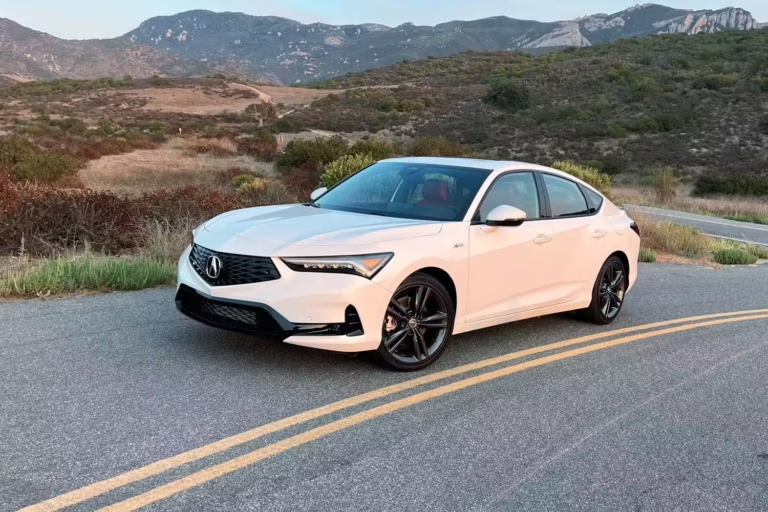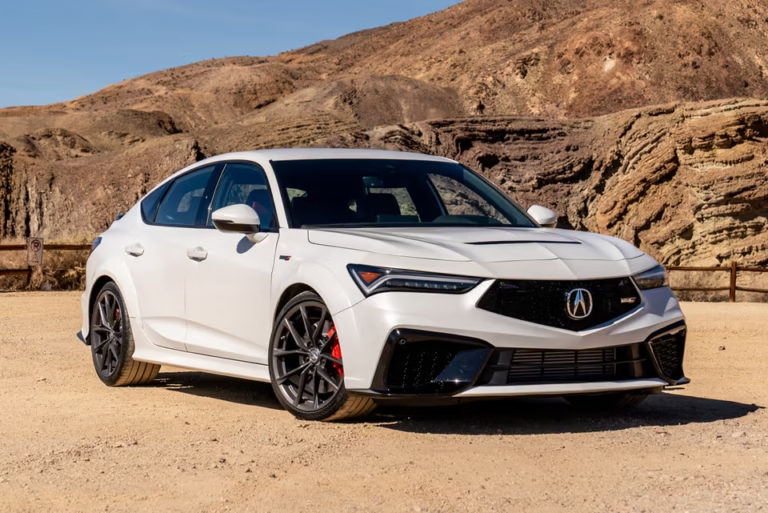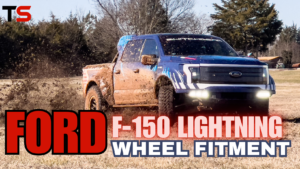Introduction
Standing the test of time, the Ford F-150 has evolved into among the most recognizable pickups available. Knowing what suits your particular model year is essential whether your wheel replacement is for a personalized look, improved performance, or both. Wheel fitment depends on wheel bolt pattern, rim size, hub bore, offsets, and tire size among other things. These all influence the comfort your truck offers, how it drives, and the appearance of the wheels once fitted.
We will walk you through the wheel fitment specifications for every model of the Ford F-150 in this handbook. We will discuss what has evolved over time, how to evaluate fitment correctly, and what factors you should take into account when choosing wheels for your F-150. From the venerable steel wheels of the first generation to the most recent models’ extreme off-road tires, our guide has you covered.
Whether your F-150 is off-roading excursions, heavy-duty use, or just trying for that ideal street stance, knowing the wheel specs will help you make the best decisions. Let’s explore the particular wheel fitment specs of every generation to enable you to choose the correct wheels for your style and need.
Wheel Fitment Basics
Making sure your new wheels look beautiful on your truck and run well depends on an awareness of wheel fitment. The major terminology and measures you should be familiar with are broken out here:
The wheel bolt pattern, sometimes referred to as the PCD (Pitch Circle Diameter), is the distance between and count of bolt holes. For the F-150, for instance, a common bolt pattern is 6x135mm on current models; previous generations can have a 5×5.5“ pattern. When selecting new wheels, be sure they mount onto your truck correctly by matching this pattern.
Two considerations define the size of the rim: width and diameter. Choose a rim size that accentuates your tire choice and vehicle setup. Depending on the model year and changes, F-150s can often manage rims ranging from 17″ to 22“. Although bigger rims can provide your truck a more aggressive stance, if combined with low-profile tires they may affect ride comfort.
The hole at the middle of the wheel that fits your truck’s hub is known as the hub bore. The right hub bore guarantees a tight fit and stops driving-related vibrations. Should the hub bore of the wheel be either too small or too large, hub-centric rings could be necessary to establish a safe connection between the wheel and the hub.
A wheel’s offset determines its position either in or out from the fender. A positive offset drives the wheel inward; a negative offset pushes it outward. Especially when raising or lowering your F-150, selecting the appropriate offset is essential to making sure the wheel clears your suspension components and doesn’t rub against the fenders.
Generation-by-Generation Wheel Fitment Breakdown (Latest to Oldest)
14th Generation (2021–Present)
Introduced in 2021, the 14th generation F-150 brought hybrid and electric variants (F-150 Lightning). Particularly with the use of more modern materials and technology, the fitting standards have changed dramatically. These trucks still have a 6x135mm bolt pattern, but wheels made for various offsets will allow off-road configurations and a range of tire sizes.
Standard across the F-150 range, the 6x135mm bolt pattern is used for the models 2021+ This makes it simple to locate a broad spectrum of suitable wheels from aftermarket companies. Many vehicles and SUVs choose this bolt pattern, hence choices are plenty.
With 18×9 and 20×10 the most often used aftermarket choices, the factory rims for the 2021 F-150 range from 17″ to 22″. Particularly when used with leveling or raise systems, larger wheels can allow a more aggressive tire configuration—that of 35’ all-terrain tires.
The 14th generation F-150’s hub bore is 87.1mm, hence when selecting aftermarket wheels, it’s crucial to make sure the hub bore either matches or utilize hub-centric rings to eliminate vibrations and guarantee a snug fit.
Wheel offsets for the 2021 F-150 vary depending on your intended application and chosen rim size from +20mm to -12mm. For off-road configurations to attain a larger stance, a more aggressive offset—negative—is advised. Remember that a bigger negative offset could call for adjustments or cutting to prevent friction.
13th Generation (2015–2020)
Among the major upgrades the 13th generation F-150 offered were a lighter aluminum body to increase towing capability and fuel economy. Particularly with the EcoBoost engine, which affects tire and wheel selections for performance and towing, fitment standards on current vehicles are somewhat more sophisticated than those of previous generations.
Like more recent F-150s, the 6x135mm bolt pattern stays standard for the 2015–2020 vehicles. Owners can upgrade or replace wheels more easily because to its constant pattern, free from concern for compatibility.
Rims run from 17′ to 22′ and the most often used ones for street, off-road, and towing configurations are 18×9 and 20×10 rims. For those wanting to improve the truck’s performance or appearance, larger rims—like 20×10—can be matched with 33″ or 35″ tires.
Like with the 14th generation, these models have a hub bore of 87.1mm. This guarantees constant wheel fitment and lowers the possibility of vibrations or inadequate alignment when using fitting aftermarket wheels.
Wheel offsets for these trucks range from +20mm to -12mm. A negative offset will push the wheels farther out, therefore widening the stance of the truck for individuals who enjoy off-roading or aggressive builds. Make sure fit is correct to prevent rubbing problems, particularly when tire size is being increased.
12th Generation (2009–2014)
With changes to the suspension and a range of engine choices—including the EcoBoost V6—the 12th generation F-150 had a more polished look. The wheel fitment needs grew somewhat more modern as the F-150 developed, still with some traditional stylistic details.
Additionally using the 6x135mm bolt pattern, the 12th generation guarantees fit with a range of aftermarket wheels. F-150 owners find it simpler to swap wheels between several model years since this standardizing spans several generations.
The most often used wheels for off-road and street builds are 18×9 and 20×9; factory rim diameters for the 2009–2014 F-150 range span from 17″ to 20″. These trucks can fit 33″ or 34″ tires without any changes based on your planned use. For those trying to increase off-road performance, 18×10 rims with a positive offset strike a mix between appearance and utility.
Assuming the proper hub size or the usage of hub-centric rings, the hub bore of the 2009–2014 F-150 is also 87.1mm, which makes fitting aftermarket wheels simple.
For these vehicles, offsets fall from +20mm to -12mm. Those searching for an off-road, wide stance will find a more aggressive negative offset ideal; those seeking a more conservative look would find a better fit from a positive offset.
11th Generation (2004–2008)
With a broader, more squared-off body, the 11th generation F-150 fundamentally changed design. Additionally featured in this generation was the SVT Lightning performance model, which affected wheel fitting decisions for high-performance configurations.
The 6x135mm bolt pattern continued from the last version. This constancy lets 2004–2008 F-150 owners pick from a range of aftermarket wheels with a perfect fit.
Rims for the 11th generation F-150 usually run from 16″ to 20″. For street projects, 17×9 and 18×9 are the most often used aftermarket options; for off-road and aggressive builds, 18×10 and 20×9 are rather popular. With a minor elevation or leveling kit, one may upgrade to **33” or 35” tires, therefore improving both off-road and on-road capability.
Like the other F-150s, the hub bore for the 2004–2008 versions is similarly 87.1mm; so, it is simple to locate matching aftermarket wheels without further modification needed.
Usually for this generation, discrepancies fall between +20mm and -12mm. While a positive offset is appropriate for a more subdued, stock-like design, an aggressive offset performs well for individuals seeking off-road excitement.
10th Generation (1997–2003)
A major overhaul, the 10th model F-150 brought a more aerodynamic body and sophisticated suspension system. Among the several variants this generation contained were the FX4 off-road package, which directly affected wheel and tire selections.
The 10th generation F-150 employs a 5x135mm bolt pattern unlike that of more subsequent generations. When searching for replacement or aftermarket wheels, this is a major difference to keep in mind since the bolt pattern varies from those on the more recent F-150s.
Manufacturer rims for the 1997–2003 F-150 vary in width from 15″ to 18″. Street vehicles usually have 16×8 and 17×8 rims; off-road constructions would benefit from 18×9 wheels with 33” or 34” tires. These trucks can accommodate bigger tires with suitable adjustments for off-road aficioners.
Like the sixth and seventh generation F-150s, this generation’s hub bore is 87.1mm, hence it is easy to locate aftermarket wheels that fit with minimum modification.
For this generation range, the most often occurring offsets span +10mm to -12mm. While a positive offset is ideal for more OEM-like systems, a more negative offset produces a wider stance, which works well for off-road driving and aggressive builds.
9th Generation (1992–1996)
The SVT Lightning performance truck changed the 9th generation F-150 significantly and affected wheel size and fitting for performance aficioners.
Usually seen on older trucks and some historic vehicles, the 9th generation F-150 makes use of the traditional 5×5.5″ (5×139.7mm) bolt pattern, which differs from the current F-150s. This pattern is therefore crucial to buy wheels especially meant for this bolt pattern.
Common aftermarket rim choices for the 1992–1996 F-150 include 15×8 and 16×8 for more aggressive builds; 15×10 rims work well with wider tires like 33” for those who want to give their truck a more tough look.
This gen have a 87.1mm hub bore, hence it’s crucial to make sure any aftermarket wheels match either the proper size or come with hub-centric rings to stop vibrations.
Usually ranging from +20mm to -12mm, offsets for this generation are negative more often in off-road configurations.
8th Generation (1980–1991)
This generation saw a change in style with more angular lines and geared to both work-oriented customers and casual driving. The 8th generation F-150 was a total redesign with more current features including an emphasis on fuel economy and enhanced aerodynamics.
Using the same 5×5.5″ (5×139.7mm) bolt pattern as the previous generation, the eighth generation F-150 This classic pattern is usually connected with vehicles of this age and older, hence when looking for aftermarket wheels, make sure they fit the 5×5.5″ bolt pattern to avoid compatibility problems.
Rims on the 1980–1991 F-150 usually ranged from 15×8 to 16×8; the most common aftermarket sizes are 15×8 and 16×8, which work well for street use and light off-roading; to fit larger tires such as 31’s or 32’s, it’s advised to use 15×10 or 16×10 rims, especially for those looking to improve off-road performance.
Like prior models, the eighth generation F-150 boasts a 87.1mm hub bore. When choosing aftermarket wheels, be sure the hub bore matches or install hub-centric rings to guarantee the wheel fits tightly on the hub of the vehicle.
Wheel offsets for this generation usually range from +15mm to -6mm. A positive offset gives the truck a stock-like look; a negative offset will offer the truck more aggressive posture, particularly for off-road use.
7th Generation (1975–1979)
This generation also signaled the end of the classic styles of the preceding decades, hence producing the more modern F-series trucks we see today. The 7th generation F-150 was debuted with a fresh look that carried an angular design and promised superior comfort and handling.
Following the pattern from the 8th generation, the 7th generation F-150 employed the 5×5.5″ (5×139.7mm) bolt pattern. Many vintage trucks still have a standard bolt design, hence fit with aftermarket wheels is usually easy.
Usually 15″ in size, factory rims for the 1975–1979 F-150 ranged from 15×7 to 15×10 in size. This truck is fit for moderate off-roading for more aggressive configurations where 15×10 rims can be utilized with 31″ or 32″ tires.
Consistent with many Ford vehicles of this era, the hub bore for the 7th generation F-150 is 108mm. Once more, it’s important to make sure any aftermarket wheels fit correctly using either hub-centric rings or the right size.
Wheel offsets for this generation usually range from +20mm to -6mm; owners want a wider stance or better clearance for off-road tires sometimes find popularity in a negative offset. For a more OEM look, a positive offset will keep the wheel tightly next to the fender.
6th Generation (1973–1974)
The “Super Cab” body type brought forward by the sixth generation F-150 fundamentally changed the F-150 lineup. Though it was a fleeting generation, this one was nevertheless a significant turning point in the development of the truck.
Like the previous generations, the sixth generation F-150 uses a 5×5.5″ (5×139.7mm) bolt pattern; this consistency makes it somewhat simple to locate aftermarket wheels, but it’s crucial to check sure the bolt pattern matches your particular model year.
Popular aftermarket alternatives for the 1973–1974 F-150 include 15×8 and 15×10, with the latter being suitable for customers wishing to install bigger off-road tires like 31’s or 32’s OEM rim sizes, which were usually 15’ in diameter with widths varying from 6’ to 8′.
With a hub bore of 108mm, the sixth generation F-150 is in line with past models and guarantees that aftermarket wheels can fit correctly as long as the hub-centric rings used have the correct diameter.
A negative offset is perfect for off-road enthusiasts who wish a wider stance and more clearance for bigger tires; the positive offset works better for stock-like setups. The offsets for this generation usually ranged from +20mm to -6mm.
5th Generation (1967–1972)
Especially with the advent of bigger engines, the 5th generation F-150 presented a more elegant appearance and more power under the hood, laying the groundwork for next generations. Its body design also changed.
Consistent with many Ford models of the era, the 5×5.5″ (5×139.7mm) bolt pattern used in the 5th generation F-150 stayed constant. Matching this pattern is essential when choosing wheels, particularly if you are thinking about aftermarket additions.
Usually ranging in width from 15 to 16 inches, factory wheels for the 1967–1972 F-150 Common sizes were 15×7 and 15×8, however for off-road use you can buy aftermarket wheels up to 15×10 to fit bigger tires like 31’s size.
Matching other Ford trucks of the era, the 5th generation F-150 has a 108mm hub bearing. As always, choose wheels with the same hub bore diameter or, if needed, hub-centric rings to guarantee correct fitment.
Usually, offsets for the fifth generation run between +20mm and -6mm. While a positive offset keeps the wheels closer to the truck for a more conventional appearance, a negative offset will provide your truck a wider stance.
4th Generation (1961–1966)
Offering more elegance and utility, the fourth generation F-150 started with a fresh “unibody” design. It also signaled the F-series trucks’ development into a genuinely flexible choice for leisure and business.
Common for many Ford vehicles, the classic 5×5.5″ (5×139.7mm) Bolt pattern used in the 4th generation F-150 makes it simpler to obtain suitable wheels, even from aftermarket sources.
When upgrading to give your truck a more current style, you can choose 15×8 rims; alternatively, 15×10 for those looking for a more tough off-road design. The factory wheels for this generation were usually 15″ in diameter and had widths varying from 6″ to 8″.
The 4th generation F-150 has a 108mm hub bore, hence it is crucial to choose aftermarket wheels using the suitable hub bore to prevent any fitment problems.
Usually ranging from +20mm to -6mm, offsets for the 1961–1966 F-150 are more aggressive negative for off-road vehicles or bigger tires and a positive offset would keep the wheels in a more factory-like posture.
3rd Generation (1957–1960)
With a more modern appearance, the third generation F-150 started to build its reputation as a dependable workhorse with flair, giving enhanced comfort and ride quality. It also brought several improvements, mostly to the body design and engine selections.
Standard for Ford vehicles of this era, the 3rd generation F-150 kept running the 5×5.5″ (5×139.7mm) bolt pattern. Ensuring the 5×5.5″ bolt pattern is matched is crucial while looking for aftermarket wheels since this has stayed a constant pattern throughout many vintage Ford vehicles.
If you want to fit bigger tires, 15×8 or 15×10 rims are standard aftermarket sizes that will provide greater clearance, especially for off-road tires like 31’s or 32’s. Typically, factory rim sizes for the 1957–1960 F-150 were 15’s with widths ranging from 6’ to 7’.
Make sure the aftermarket wheels you purchase have the proper hub bore diameter or use hub-centric rings to guarantee a tight and safe fit. The third generation F-150 has a 108mm hub bore.
While a positive offset will keep the wheels closer to the truck, so preserving a more factory-like appearance, choosing a negative offset is often preferred for those who want a wider stance or larger tires, especially for off-road use. The usual offsets for this generation ranged from +20mm to -6mm.
2nd Generation (1953–1956)
Although it still had much of the toughness of its predecessor, the second generation F-150 concentrated more on providing a better driving experience with improved looks and options. Its design was more polished with smoother lines.
The second generation F-150 kept running the 5×5.5″ (5×139.7mm) bolt pattern. Many classic Ford vehicles still show this since Ford trucks’ preferred choice remained. Verifying that the bolt pattern fits will help you find replacement or aftermarket wheels.
Manufacturer rim sizes for the 1953–1956 F-150 were 15″ in diameter, usually varying from 6″ to 7″ in width. Common aftermarket wheel sizes accommodate bigger off-road tires or provide the truck a wider stance: 15×8 or 15×10.
Using a 108mm hub bore, the 2nd generation F-150 is in line with subsequent Ford models. As usual, be sure the hub bore is the same or use hub-centric rings to guarantee the proper fitting if you are searching for aftermarket wheels.
Usually ranging from +20mm to -6mm, the offsets for this generation were negative for off-road configurations to provide a broader stance and fit bigger tires. A positive offset guarantees the wheels lie closer to the fenders and preserves a factory look.
1st Generation (1948–1952)
The first model F-150 launched what would become one of the most famous truck lines in automotive history. Designed mostly for labor but also able to provide comfort and utility for personal usage, this was a revolutionary vehicle in its day.
Finding appropriate wheels with the 5×5.5″ bolt pattern is essential when upgrading since the first generation F-150 made this pattern the standard for Ford trucks for many years and is still in use today in some classic Ford vehicles.
Usually featuring 15″ diameter rims and widths varying from 6″ to 7″ the 1948–1952 F-150 While aftermarket choices like 15×8 or 15×10 can be used to fit larger tires, especially for those wishing to customize for off-road use, 15×7 rims are a typical choice for a factory-like appearance.
The 108mm hub bore of the first generation F-150 matched many Ford vehicles of that day. Making sure the hub bore size matches will help you choose aftermarket wheels; alternatively, hub-centric rings will guarantee a perfect fitting and security.
Wheel offsets for the first generation F-150 usually run from +20mm to -6mm; negative offsets are more suited for individuals who wish to fit bigger tires or provide the truck a more aggressive stance. For a more stock look, a positive offset keeps the wheels nestled in closer proximity to the vehicle.
Lug Nut Types by Generation
The generation of your Ford F-150 will determine the kind of lug nuts needed since the wheel designs, bolt patterns, and general fitment change with time. Early generations, like the 1st and 2nd, used standard hex nuts with a 5×5.5″ bolt pattern, commonly employing acorn-style nuts. These lug nuts feature a conical seat that tightly grips the wheel’s lug hole. As Ford progressed through generations, such as in the 3rd and 4th, the same acorn-style lug nuts were used, though certain models began to introduce closed-end variants for extra protection. In later generations, specifically from the 9th onward, Ford shifted to the more modern 5x135mm bolt pattern, and the lug nut style adjusted to accommodate these changes. By the 10th and 11th generations, Ford also began to implement flanged nuts or ball-seat lug nuts for improved wheel-to-hub connection, providing a more stable and secure fitment. The lug nut style can significantly affect your F-150’s wheel installation and fitment, and using the correct lug nut type is crucial for safety and performance. It’s essential to always check your vehicle’s specifications and use the right type of lug nut for proper wheel attachment, ensuring your wheels are securely fastened to avoid any road safety issues.
How to Measure and Test Fitment
Starting with your bolt pattern—usually either 5×5.5″ or 5x135mm, depending on your generation—accurately measuring and testing wheel fitting for your Ford F-150 is essential for both aesthetics and vehicle safety. This is accomplished by gauging the distance separating the centers of two opposed bolt holes. Then, based on wheel width and diameter, ascertain the rim size. Make sure the wheel width and diameter complement the criteria of your truck so that tires may fit properly with appropriate room. Still another important consideration is the hub bore size. Though it varies depending on generation, the hub bore of the F-150 normally measures 108mm. Hub-centric rings can help you to guarantee a safe fit if the hub bore of the wheel differs from that of your truck. Then, examine the wheel offsets—that is, the distance from the wheel’s centerline to the mounting surface. A positive offset drives the wheel inward toward the vehicle; a negative offset drives it outward. At last, test fitting the wheels is essential to find clearance problems such interference with brake calipers or suspension parts. Measuring these components precisely guarantees that your Ford F-150 fits you correctly and helps you to prevent any performance problems.
Top Aftermarket Wheel Brands for F-150
Several aftermarket companies provide premium choices for replacing the wheels of your Ford F-150 that can improve the utility and appearance of your truck. For off-road aficioners, Fuel Off-Road is well-known for their tough, fashionable wheels. Their designs appeal to vehicle owners seeking strong looks combined with longevity. Another great brand is KMC Wheels, which uses a range of styles and finishes to provide both performance and visual attractiveness. KMC wheels give strength and the capacity to negotiate challenging terrain, therefore fit for off-road use. Black Rhino Wheels is a fantastic option for individuals looking for heavy-duty wheels with original designs. Since their wheels are made especially to resist severe off-road situations, F-150 owners who wish to push their vehicles to the maximum will find them ideal fit. With its aggressive designs and tough performance and aftermarket wheels in a range to complement the look of your F-150, Moto Metal also distinguishes itself. At last, American Racing guarantees longevity by offering traditional and modern-style wheels distinguished for performance and premium materials. From elegant street-style wheels to ones designed for off-road capability, these brands provide a wide spectrum of wheel types and sizes that let F-150 owners select what best fits the needs and appearance of their truck.
FAQs
Q1: What is the bolt pattern for the Ford F-150?
Older models of the Ford F-150 had a 5×5.5″ (5×139.7mm Bolt design; the 9th generation and future models (2021 and beyond) utilize a 5x135mm Bolt pattern.
Q2: How do I know which offset to choose for my F-150?
Go with a negative offset if you want an aggressive look and better off-road performance; a positive offset brings the wheel closer to the truck. For a stock setup, a positive offset is perfect.
Q3: Can I use larger tires with aftermarket wheels?
Popular tire sizes for off-roading are 31’s and 33’s, but always check with your wheel and tire specialist for the perfect fit. Aftermarket wheels can accommodate larger tires, but choose the appropriate rim size, offset, and Bolt pattern to guarantee a proper fit.
Q4: What’s the most important factor when choosing wheels for my F-150?
The most crucial elements are the bolt pattern, offset, hub bore size, and rim size; make sure the new wheels satisfy your needs and always test fit to guarantee compatibility before you decide to buy.
Q5: Do I need to change lug nuts when upgrading wheels?
Indeed, depending on the kind of wheel, you could have to replace or upgrade the lug nuts. For example, whereas earlier models might need acorn-style nuts, modern wheels with flanged nuts might need flanged lug nuts.
Conclusion
Wheel fitment for the Ford F-150 has changed as shown across the several generations, however several fundamental parts including bolt patterns (5×5.5″), rim sizes, hub bore (108mm), and offsets have been constant over several decades. To guarantee fit while changing wheels for your Ford F-150, give these elements great thought. Selecting the correct fitting will greatly improve the appearance and performance of your truck whether your style is aggressive off-road or stock.
See an expert or your local tire dealer if you still have questions regarding the fitment for your F-150 or wheel or tire recommendation.







